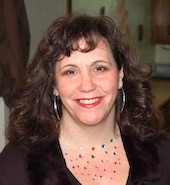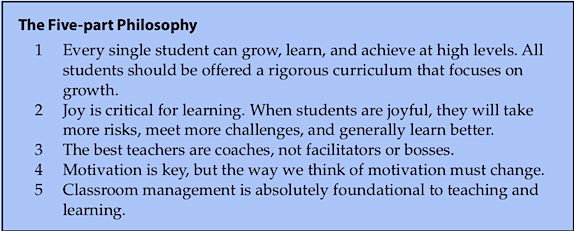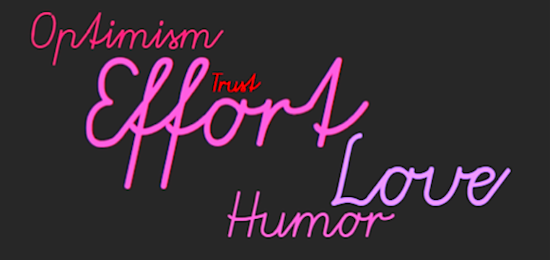Students Will Thrive in a Culture of Effort and Joy
As you enter Mrs. Miner’s sixth grade classroom the first thing you notice is that all students are on task. Students are everywhere but all seem to be engaged in the learning target set forth by the teacher. Moreover, everyone seems happy! Students sit close to one another, smile often, and their quiet whispers are often punctuated by laughter.
The room is clearly arranged to meet learners’ various needs. About half of the tables at the center of the room are filled with small groups of students talking quietly as they work on gathering and sharing information for a project. There are three study carrels on the back wall with signs above them that read, “Shhhh! Quiet Study Area!” One of the carrels houses a student who is independently reading and taking notes from an article.
Along another wall is a tall table with bar stools for seating; there, students are working in groups of two with laptops open. Mrs. Miner’s desk is in the far back corner of the room but it is empty. She sits at a kidney-shaped table near the front door working with three students. You notice that she occasionally points to the chart on the wall behind her to emphasize a point.
When Mrs. Miner needs the attention of her class, she rings a bell and raises her hand. In seconds, all students but one turn toward her. Mrs. Miner politely asks the one student who has not come to attention to please follow directions. The student apologizes and looks at Mrs. Miner. She shares information with the students and asks for volunteers to summarize the work they have done. Many hands shoot up, as students are eager to share. In sharing, students are attentive, ask each other follow-up questions, make connections with one another, and often laugh.
As students finish up, Mrs. Miner asks them to put away their work and get ready for lunch. When the children get in line, Mrs. Miner puts a hand on shoulders here and there and stops to chat with individuals who want to share one last thing with her. As she walks them to lunch, she smiles and wishes all a nice break.
The Big Idea
Most teachers would love to have a classroom like the one described above. It is a classroom that buzzes with cheery productivity, and that type of classroom is wonderful for all who have a stake in it.
From teachers and students to parents and administrators, everyone wins when classrooms are focused on learning, yet joyful. Mrs. Miner’s classroom is an example of a place where learning and joy go hand in hand, and that is what my book Working Hard, Working Happy is all about.
In a nutshell, the theory is that the most effective classrooms are those where students and teachers alike are happy and hardworking. Having spent 23 years as a teacher and curriculum coach in a wide variety of grade levels and schools, I have come to realize that the best classrooms are those that have heady doses of both fun and high expectations.
My Five-Part Philosophy
What is your philosophy of education? This was the question a professor asked in the second year of my teacher education undergraduate program. Philosophy of education? I had no idea.
In fact, it wasn’t until very recently that my philosophy was anything but an inchoate slush of ideas, inclinations, and questions. Though I know that my philosophy will grow and change, almost 25 years after that question was asked, I think I have an answer.
Identifying an education philosophy helps teachers . . .
★ Focus our efforts on what we believe is truly important.
★ Stay true to our core values.
★ Rejuvenate our love of teaching and remind us why we became a teacher in the first place.
★ Make decisions about whether a given school will be a good fit for us.
★ Find allies and thought partners to widen our professional connections.
I have taught grades 1, 2, 4, 5, and 7 and remedial classes in high school. I have worked as a mentor, a cooperating teacher, a professional development coordinator, a reading specialist, and a librarian. Among other places, I have loved students in tiny Yupik villages on the Bering Sea Coast, in inner city Las Vegas, and in rural Wisconsin.
I have sat on every possible type of committee and attended more meetings than anyone should ever have to attend. I earned National Board Certification, published in journals, presented at conferences, and embraced the connective power of the internet to grow my own personal and professional learning networks.
Most important, each year I have loved my profession more deeply and each year has been seminal in my growth as an educator and as an educational philosopher. (Yes, I’m not afraid to call myself that anymore!)
Today my philosophy boils down to a list of five things I know to be true about teaching and learning. In my experience, these are among the most important truths for successful educators.
Now that you’ve taken a minute to read through the five-part philosophy, let’s look at each point in greater depth.
1. Every single student can grow, learn, and achieve at high levels. All students should be offered a rigorous curriculum that focuses on growth.
All children want to learn and all crave challenge. Students thrive when they work to meet challenging goals in supportive learning environments. So-called “failure” is a part of learning and should be celebrated as part of the process. In the book, you’ll read about the research on growth mindset by Carol Dweck (2017), as well as encounter the scholarship on harnessing the power of “failure” as a way to help students recognize themselves as active learners.
Students with teachers who support the goal of helping them make at least a year’s growth in a year’s time are bound to achieve more than are students in classrooms where no such expectation is maintained.
Take reading in a fifth grade classroom, for example. A student who begins the year reading approximately at the seventh grade level should be challenged to grow to approximately the eighth grade level by year’s end. Similarly, a student who begins fifth grade at a second grade reading level should be challenged and supported such that she reaches at least at the third grade level. Both learners should be coached so that they work hard and celebrate their own successes and actually make documented growth.
2. Joy is critical for learning. When students are joyful, they will take more risks, meet more challenges, and generally learn better.
Students are in school for a huge chunk of every day. Teachers can and should be actively working to make that time as joyful as possible. When students are happy, they are likely to be motivated to work harder.
Don’t make the mistake of thinking that a joyful classroom is equivalent to a free-for-all environment. Remember, the premise of this book is that joy and serious learning go hand in hand. Joyful classrooms can look and sound very different depending on the teacher, the lesson, or even the time of day.
While games, jokes, and other fun can be a part of a joyful classroom, so can a productive buzz or even a completely silent learning space.
3. The best teachers are coaches, not facilitators or bosses.
Coaching can be defined as the art and science of helping someone achieve their goals through explicit teaching, modeling, hands-on guided practice, and lots of independent practice. Teachers cannot make learning happen; they can, however, help students acquire knowledge, skills, and tools so that students can make it happen for themselves.

4. Motivation is key, but the way we think of motivation must change.
Motivation comes from success and from feeling good about your work; it comes from “seeing” growth through setting, monitoring, and meeting learning goals. Motivation is not something we give to students; it is something we teach to students.
Real motivation comes from seeing success as possible. Recognition and celebration of growth toward goals should be frequent and pointed. Sometimes, that means a sticker, a certificate, a star on a chart or some other token, but most of the time it means conferring with students so that they begin to see the results of their own hard work to learn and grow.
5. Classroom management is absolutely foundational to teaching and learning.
Unless a teacher has her or his finger on the pulse of the classroom and can easily facilitate student transitions, stay organized, keep disruptive behavior to a minimum, and have fun, she or he cannot effectively teach.
If students are to make progress in their own areas of need, teachers must be able to flexibly differentiate instruction so that all learners have access to rigorous content in a safe and orderly environment. Differentiated instruction has a reciprocal relationship with classroom management.
Your Turn!
★ Do you agree with the five-part philosophy? What would you change to make it better fit your own experiences and beliefs about what constitutes good teaching?
★ Define your own philosophy of learning. Ask yourself the following questions and use the answers to guide you.
- What do you hold most dear as a teacher?
- What truths guide how you interact with your students?
- What was your best experience as a student? As a teacher?
- What is your biggest hope for your students?
- What do you think works in teaching and learning? What doesn’t work?
Knowing and being able to articulate your philosophy can be a very helpful touchstone for a teacher. Once we have identified what we believe is truly important, we can weigh our actions, lessons, and approaches against those ideals. If a teacher is doing something that does not feel impactful in light of her or his philosophy, there might be a problem, and problems can be fixed when we can pinpoint them.
Working Hard, Working Happy: The Weave
Now you have a good idea of my philosophy of education. Below, my MiddleWeb editors have kindly included brief chapter descriptions of my book Working Hard, Working Happy, so you can see how each of the five parts is woven into the book’s structure.
Chapter 1: Working Hard, Working Happy
As you know by now, this first chapter serves as an introduction to the book. It explains the five-part philosophy of learning that undergirds the methods and strategies offered in the subsequent chapters.
Chapter 2: Joy and Effort, Best Friends Forever!
The most effective classrooms are those where students and teachers alike are happy and hardworking. This chapter will focus on the whats and whys of a high-functioning classroom. Here, the relationships between fun, high levels of self-efficacy, personal satisfaction, rigor, and student effort will be explored. The chapter is organized around Daniel Pink’s notions of purpose, mastery, and autonomy/ownership.
Chapter 3: Where Everyone Knows Your Name
Happy classrooms, where all students are willing to take risks and challenge themselves, begin with a foundation of strong relationships between all stakeholders in the classroom. Teachers and students must know and respect each other, and that must also be true between students. Building relationships, a strong foundation of classroom management, and a culture of caring will be addressed with the overarching goal of building safe classrooms for all learners. Without a safe, respectful classroom, learning is not likely to happen.
Chapter 4: Mastery Matters!
Motivation can hinge on students seeing themselves as capable of mastery. Once students learn to set and meet goals, they will begin to see themselves as successful and autonomous learners. Helping students see their own learning will make the classroom happier and more productive. This chapter will explore strategies to build students’ abilities to master material and to see themselves making progress.
Chapter 5: Have It Your Way! Differentiated Instruction
If students are to be successful, then teachers must learn to differentiate instruction in meaningful and varied ways. This chapter will help teachers explore ways to differentiate instruction such that all students are working toward rigorous learning goals within their own zones of proximal development.
Chapter 6: Social Animals
Students, like all human beings, are social animals. This chapter will help readers to harness that social drive and energy through various formal and informal cooperative learning techniques. When students work together and have a shared vision, they are likely to be happier. That can help a teacher to motivate all to work hard and learn with and from each other.
Chapter 7: Busting Down the Walls, Building Community Connections
In addition to feeling known by the teacher, students who are taught by teachers who are integrated into the community and have frequent and positive interactions with parents are likely to work harder and experience the classroom as a joyful place. This chapter will focus on helping teachers to reach out and support the community at large and, in turn, receive support from it.
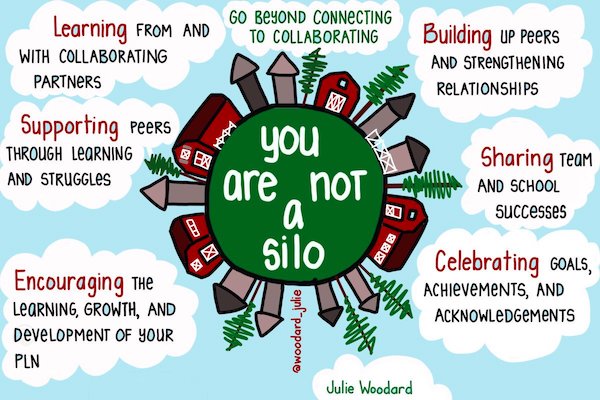
One of the best sketchnotes I discovered this year! (Source)
Chapter 8: Effort and Joy, They’re Not Just for Students!
Teachers have a hard job. If it is to be a doable and long-lasting career, then we must do two things. One, point our efforts in the most impactful direction, and two, increase and sustain joy in our working lives. PLNs and professional collaborators can help!
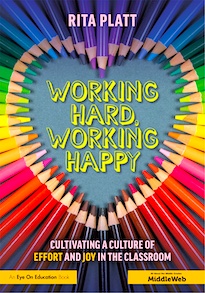
Her book Working Hard, Working Happy: Cultivating a Culture of Effort and Joy in the Classroom is published by Routledge Eye on Education and MiddleWeb.

